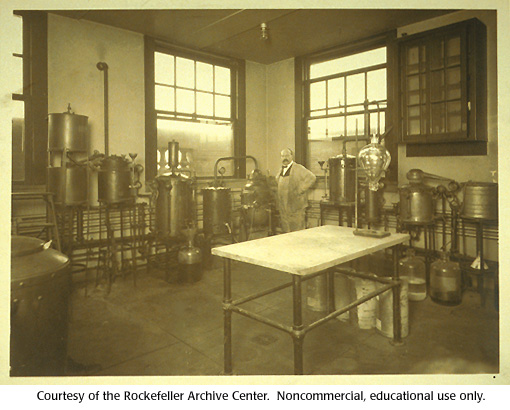Gallery 15: Levene's laboratory at the Rockefeller Institute, 1922. (4 of 4)

Levene's laboratory at the Rockefeller Institute--used for distillation purposes.
rockefeller institute, levene, distillation
- ID: 16350
- Source: DNALC.DNAFTB
Related Content
16349. Gallery 15: Levene's laboratory at the Rockefeller Institute, 1922. (3 of 4)
Levene's laboratory at the Rockefeller Institute.
16348. Gallery 15: Levene's laboratory at the Rockefeller Institute, 1922. (2 of 4)
Levene's laboratory at the Rockefeller Institute, 1922.
16347. Gallery 15: Levene's laboratory at the Rockefeller Institute, 1922. (1 of 4)
Levene's laboratory at the Rockefeller Institute, 1922. Levene had a large lab space; note the type of equipment used at the time.
16357. Biography 15: Phoebus Aaron Theodor Levene (1869-1940)
Phoebus Levene was an organic chemist in the early 1900's. He is perhaps best known for his incorrect tetranucleotide hypothesis of DNA.
16379. Gallery 17: Oswald Avery's memorandum of appointment
Memo approving Avery's appointment to the Rockefeller Institute.
16405. Gallery 18: Joshua Lederberg, 1999
Joshua Lederberg in his office at the Rockefeller Institute, 1999.
16352. Video 15: Thomas Sakmar, clip 1
Comments on some of the prevailing theories of the time and Phoebus Levene's basic hypothesis
16353. Video 15: Thomas Sakmar, clip 2
Phoebus Levene's contributions -- the distinction between DNA and RNA.
16354. Video 15: Thomas Sakmar, clip 3
The work of Erwin Chargaff and how it contributed to the downfall of Levene's tetranucleotide theory.
16355. Video 15: Thomas Sakmar, clip 4
Did Levene's tetranucleotide theory affect the development of ideas in the field of nucleic acid research?












